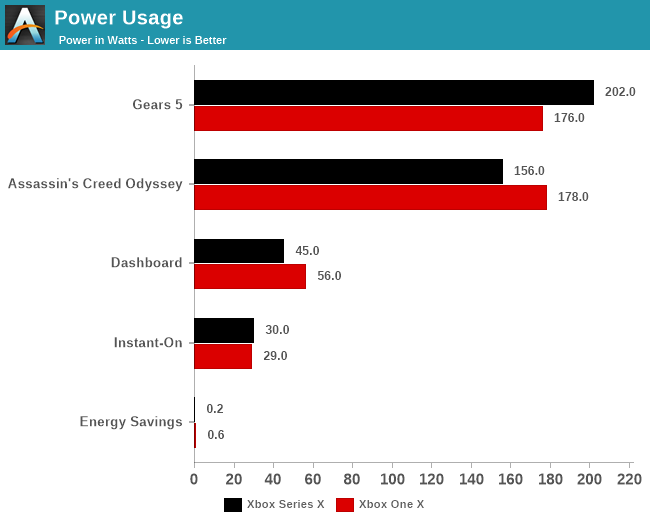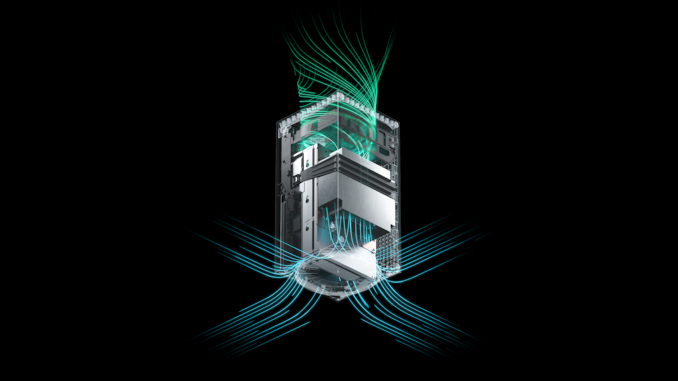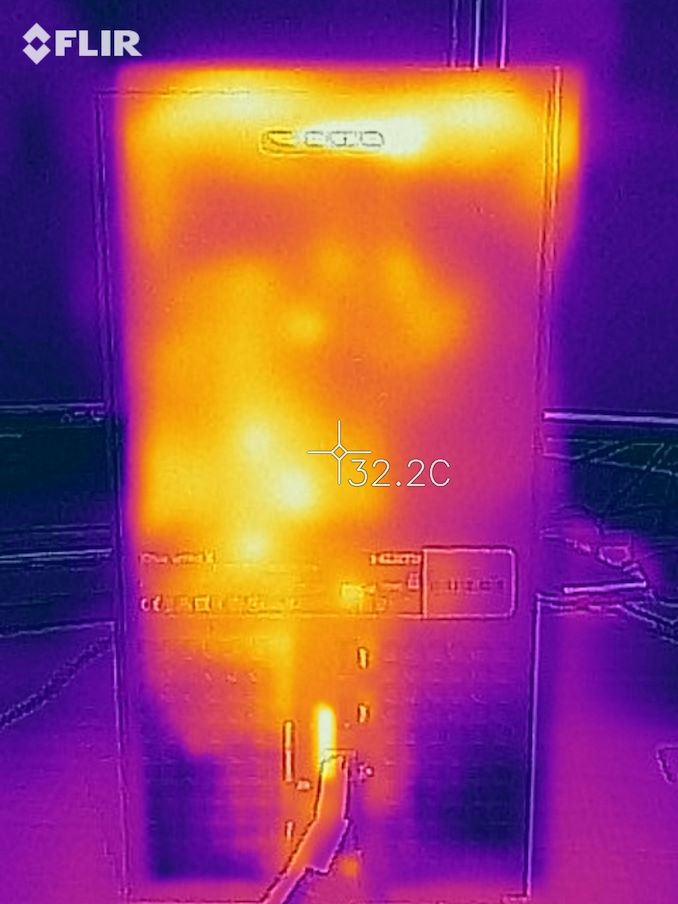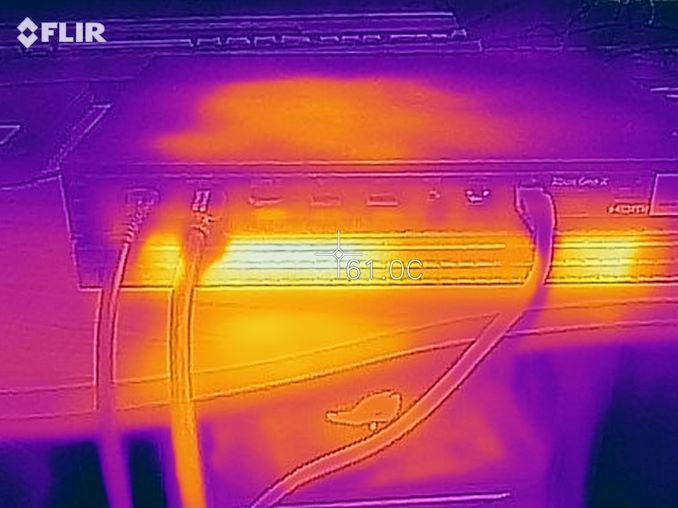The Xbox Series X Review: Ushering In The Next Generation of Game Consoles
by Brett Howse on November 5, 2020 9:00 AM ESTPower and Thermals
Packing all this performance into the new Xbox Series X was most certainly going to be an engineering challenge to deal with the heat generated. The design of the new console is a clear indication that heat was one of the top priorities when engineering the console. The open-top design creates convection currents which naturally draw heat to the top, and the Xbox also adds in a large fan at the top to encourage the hot air to move out the top of the device. There is a split-motherboard as well, separating the high-heat components like the SoC, and the storage, to allow for a more evening cooling.
Microsoft outfitted the Xbox Series X with a large passive heatsink as well, with vertical fins as part of the “parallel cooling architecture” which allows the air to rise through the heatsink and be cast out of the top of the device by the fan, similar to how a server CPU would be cooled.
First, let’s see what kind of power figures the Xbox Series X generates.

When in the energy savings mode and powered off, the Xbox Series X drew just 0.2 watts of power, which was a bit less than the Xbox One X. In the instant-on mode, that figure jumps up to 11-29 watts. One of the biggest advantages of Instant-On was, as it is named, how quickly the console resumed, but thanks to the Xbox Velocity Architecture and the console’s incredible boot time, it may not be worth running that mode. Instant-On also allows for games to be updated in the background, as well as the console to be remotely access to start a new game download, as an example, and those would still be benefits, but the power difference is significant and if you are OK not having that you can save some on your power bill.
In fact, it would be nice if Xbox offered a hybrid mode, where the console would be in full-off mode, but then wake every 8 hours or so to check for updates, apply them, and go back to off. Maybe someday.
Powered on and sitting idle at the dashboard, and the new Xbox Series X is a bit more power efficient than the Xbox One X, thanks to the 7 nm process, and it consumes around 44-45 Watts at idle.
That trend continues with a backwards compatible game in Assassin’s Creed Odyssey. The new console consumes almost 25 Watts less power in the same portion of the game to achieve the same performance levels. The new 7 nm process and RDNA 2 architecture is showing its strengths.
Moving to a game optimized for Series X in Gears 5, which features 4K60 gameplay and cut scenes, and the Xbox Series X finally eclipses the Xbox One X, which also offers 4K60 gameplay in this title. But still, a hair over 200 Watts of total device power is particularly good for a 4K60 game. If you look at the Radeon RX 6800 graphics card, it has a total board power of 250 Watts for 13.9 TFLOPS vs 12 TFLOPS in the Xbox Series X, and the Xbox also includes the CPU, storage, and all other aspects. Microsoft has clearly paid close attention to the DVFS curves on the Zen 2 and RDNA 2 components, keeping them from getting too far out of hand and causing a significant power requirement increase for a minimal performance gain.
Looking at the infrared signature from the Xbox Series X, and we see pretty normal results for a console.
The heat is unsurprisingly concentrated on the top of the system, where the fan is expelling the hot air. The console gets warm, but never hot, and the heat output and temperatures are really not much different than the Xbox One X.
Noise is a different story though. The Xbox team has hit one out of the park here. At idle, the Xbox Series X is basically silent. The SPL meter could not detect the Xbox Series X over the baseline noise in the room, so it read about 36 dB(A) measured one inch in front of the console. At load, the noise level basically did not change, with a measurement of 37.3 dB(A). That is an incredible result for a console with 12 TFLOPS of graphics performance and the ability to pull 200+ Watts.
As a comparison, the Xbox One X, which should be stated is three years old now, with three years of dust and wear on the fan, idled at 38.5 dB(A) measured one inch in front of the console, and ramped up to 45 dB(A) under load playing Gears 5. To put this difference in perspective, the new Xbox Series X is quieter playing Gears 5 than the Xbox One X is at idle. The attention to detail on cooling and sound by the Xbox team is really a homerun here.














68 Comments
View All Comments
eastcoast_pete - Saturday, November 7, 2020 - link
You're correct, and Brandon was outstanding in this movie (by Elia Kazan, I believe). Thought Stallone did borrow that line for Rocky, but it's been a while that I watched it. That being said, the "S" is at risk of being the bum among consoles, and the fact that it's readily available for pre-order suggests it's not rocking many boats out there.flyingpants265 - Friday, November 6, 2020 - link
One or two of the cores are doing things not related to games.flyingpants265 - Friday, November 6, 2020 - link
What exactly is the point of the Series S? The whole point of consoles is that they're standardizedandrewaggb - Friday, November 6, 2020 - link
The trend started with the ps4 pro and xbox one x. They're still fairly standardized, same peripherals, same cpu, same gpu archicture, same software. Series S is just for 1080p only and will probably have somewhat lower quality textures because it has less ram.Shlong - Monday, November 9, 2020 - link
The Series S also doesn't have updated graphics for backward compatibility games. The graphical updates for Xbox One games will show up on Series X but not S.cmdrdredd - Monday, November 9, 2020 - link
That went out the window a while back. Now it's just a brand, the Xbox. All games using smart delivery work on any Xbox One or Series console and will use the appropriate settings and resolution for that console. Not unlike graphics settings in your PC. I could ask what the point of a RTX3070 is and the answer is the same. A lower power and cheaper alternative that is good enough for a lower resolution.eastcoast_pete - Friday, November 6, 2020 - link
Thanks for the first look/review, Brett! Question: Did you have a chance to see just how fast the USB 3.1 connection is when a. Used with an external SSD or b. a regular 7200 rpm HDD. Especially interested in getting an idea how fast or slow it is to transfer some of the games you tested back into the built-in SSD. If you haven't tested it but still have the unit, can you try it? Thanks!Brett Howse - Saturday, November 7, 2020 - link
Thanks for the question. I don't actually have a USB SSD drive to test this. I do have a slower USB HDD but I think it would end up being the bottleneck and would give unreliable results. I think whether this is worth it for you is whether you have fast internet or not.I'll still try the USB HDD this weekend and just see how it goes and let you know.
eastcoast_pete - Saturday, November 7, 2020 - link
Thanks Brett, even a regular HDD will give an initial idea. Regarding an external SSD: Maybe someone else at AT has an external SSD they can lend you? With the current pricing for the proprietary add-on SSD, a half-priced external SSD connected by USB 3.1 is an interesting alternative. Assuming the Series X supports about 350 - 400 MB/second over USB, I'd probably get a 1TB external SSD and keep an external 8 TB HDD for "cold storage".Brett Howse - Saturday, November 7, 2020 - link
Just so you are clear on this, any USB connected drive is not capable of being used for Series X|S games. It can be used for storage only. To play the new games they have to be on internal storage or on the Seagate storage drive. You'd have to shuffle games around if you want to keep them on USB.